Vitrification Market Size
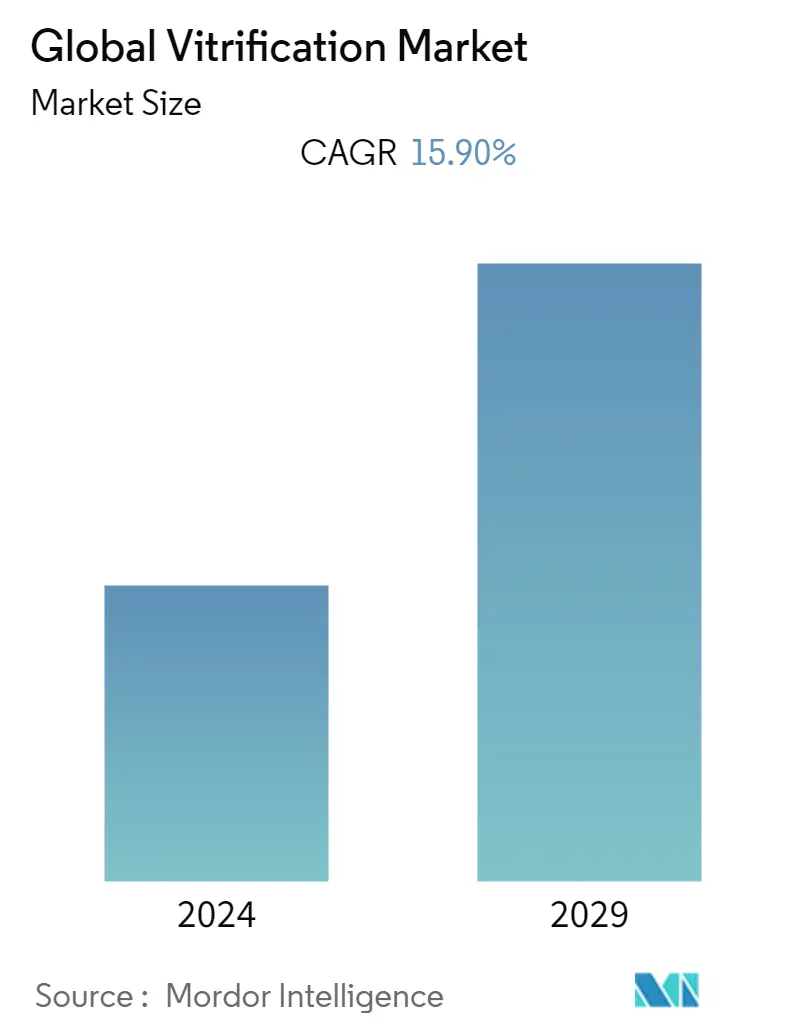
| Study Period | 2019 - 2029 |
| Base Year For Estimation | 2023 |
| CAGR | 15.90 % |
| Fastest Growing Market | Asia-Pacific |
| Largest Market | Europe |
| Market Concentration | Medium |
Major Players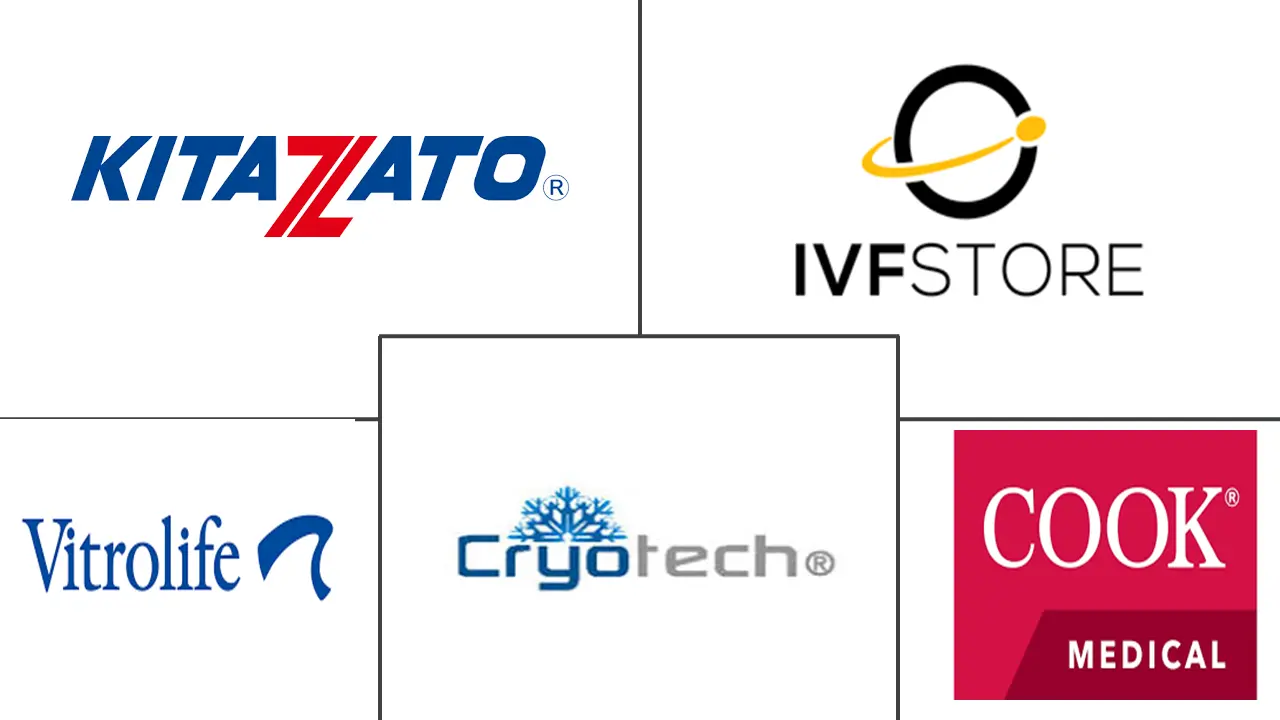
*Disclaimer: Major Players sorted in no particular order |
Need a report that reflects how COVID-19 has impacted this market and its growth?
Vitrification Market Analysis
The vitrification market is projected to register a CAGR of 15.9% during the forecast period (2021-2026).
During the Covid-19 pandemic, scientific groups such as the European Society for Human Reproduction and Embryology and the American Society for Reproductive Medicine have issued advice and guidelines to help people who are undergoing in-vitro fertilization treatments overcome and flatten the infection curve. There is no significant impact of Covid-19 on the vitrification market, as the process involves controlled procedures, that reduce the risk of contamination of the samples during vitrification and storage. They can successfully reduce the danger of cross-contamination and infection caused by the current Covid-19 pandemic or other viral exposures.
Many factors are propelling the market growth, some of them include, growth in fertility preservation techniques delayed childbearing due to sociodemographic factors, and increasing awareness of reproductive health among people. Several studies and trials have been undertaken to demonstrate the efficacy of vitrification over slow freezing, resulting in its expanded clinical use. Most Invitro Fertilization (IVF) clinics are currently employing this procedure to freeze eggs/embryos and provide a better success rate to patients, which is driving the industry. Besides this, various firms provide cost-effective specimen preservation services, which expands the vitrification market's potential
Furthermore, delayed childbearing is due to sociodemographic factors is also contributing to the vitrification market. Delayed childbirth is a significant shift in reproductive behavior that affects all developed countries. This has increased the number of births among women in their forties and fifties. For instance, according to a study published in 2019 in Cairn.info, a French-language web portal of humanities and social sciences, infertility rates rise rapidly, with the percentage of women who are unable to conceive rises from 17% at age 40 to 56% at age 45. To overcome this problem and postpone their parenthood, people are inclined towards vitrification. For instance, according to the Centers for Diseases Control and Prevention (CDC), in 2019, 448 reporting clinics in the United States executed 330,773 Assisted Reproductive Technology (ART) cycles, resulting in 77,998 live births (delivery of one or more living newborns) and 83,946 live-born infants. In 2019, 121,086 of the 330,773 ART cycles were egg or embryo banking cycles, in which 100% of the resultant eggs or embryos were saved for future use. Therefore, delayed parenthood in developed countries resulted in an inclination towards vitrification, which in turn boosts the market growth.
Vitrification Market Trends
This section covers the major market trends shaping the Vitrification Market according to our research experts:
Oocyte Freezing Segment Is Expected to Hold A Major Share in The Vitrification Market
Mature oocyte vitrification is widely considered a significant advancement in assisted reproductive technology (ART) in recent years and accounts for a major share in the vitrification market. A growing number of women are opting to preserve their fertility through this method, both to delay childbearing and for medical reasons such as cancer. As oocytes are particularly sensitive to cryopreservation because of their huge size, low surface area to volume ratio, relatively high water content, and presence of the meiotic spindle, vitrification is a preferred technique over cryopreservation for oocytes.
Furthermore, many major players are also coming forward to deliver devices, kits, and consumables for Oocyte vitrification, in turn contributing to the market share. For instance, Cryotop is a unique vitrification container designed by KITAZATO CORPORATION has been used in over 1,500,000 clinical instances in over 90 countries and 2,200 assisted reproduction clinics for more than a decade. Moreover, the success rates of fertilization via oocyte vitrification are also significantly high and have given the best results. For instance, As per the comparative study conducted in 2019 in World scientific, an academic publisher, between fresh and cryopreserved oocytes in an oocyte donation program, a total of 600 oocytes were investigated (226 vitrified oocytes and 374 fresh oocytes). After warming, 218 oocytes survived, resulting in a 96.4 percent survival rate. The fertility rate was 86.2 percent, while the embryo formation rate was 93.6 percent. Therefore, higher success rates of vitrified oocytes and the inclination of key players towards this segment may result in a major share for this segment in the vitrification market.
Below is a bar graph showing the comparative analysis of fertilization rate between vitrified oocytes and fresh oocytes. The data shows that the fertilization rate of vitrified oocytes is nearly equal compared to the fertlization rate of fresh oocytes.
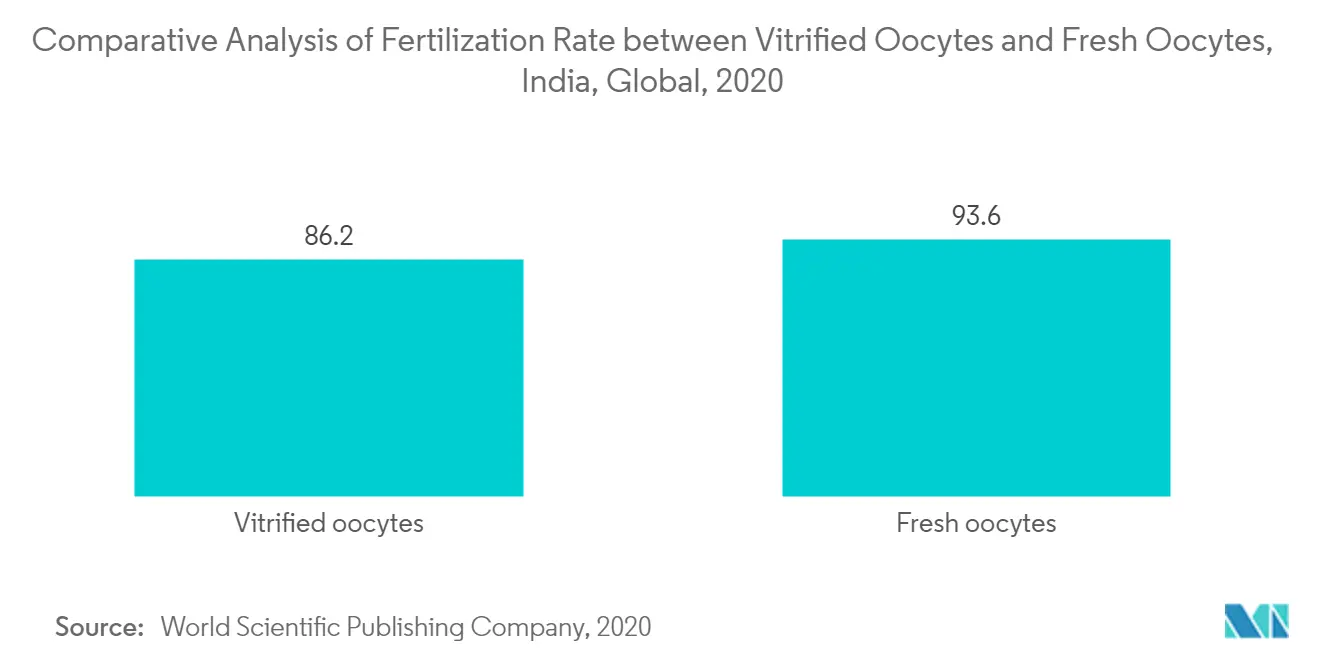
Europe is Expected to Hold a Significant Share in the Market
Europe is expected to dominate the vitrification market due to the rise in infertility rates, rising public knowledge of fertility treatments, technical improvements, and government initiatives that have all contributed to Europe's dominance. Many ART cycles will take place in Europe due to the well-established presence of IVF clinics.
Delay in parenthood has become increasingly popular in Europe. According to the Centers for Disease Control and Prevention (CDC), The rate of IVF fertilization in the 35-39-year age range is significantly high, as the eggs generated by the reproductive system are less efficient for fertilization with male spermatozoa in older women, that increases the risk of genetic abnormalities. For instance, According to Epidemiology for public health reports, in Italy, the number of cycles completed in 2018 is 8434 compared to 7514 in 2017, with a rise of 12.2%. Treatment with female donor gametes (oocytes) was the most common method (5901 cycles, or 46.5 percent of the total), followed by donor embryos (2783 cycles, or 41.1%), and donor sperm(839 cycles, 12.4 percent). The number of ART cycles using pre-implantation genetic diagnosis increased as well (3441), as did the number of facilities that provided this service (rising from 42 in 2017 to 46 in 2018). As a result of the use of these approaches, 705 live births have been recorded.
According to the European Society of Human Reproduction and Embryology (ESHRE) report published in 2019, Spain remains the most active country in Europe in terms of assisted reproduction, with a total of 140,909 treatment cycles conducted. Spain maintains its lead over Russia (121,235 cycles), France (104,733), and Germany (104,733). (969,226). Treatments involving IVF, ICSI, intrauterine insemination, and egg donation are among the cycles monitored by ESHRE.
Moreover, well-established IVF services and the presence of favorable healthcare infrastructure are fueling the growth of the overall regional market to a large extent in Europe.
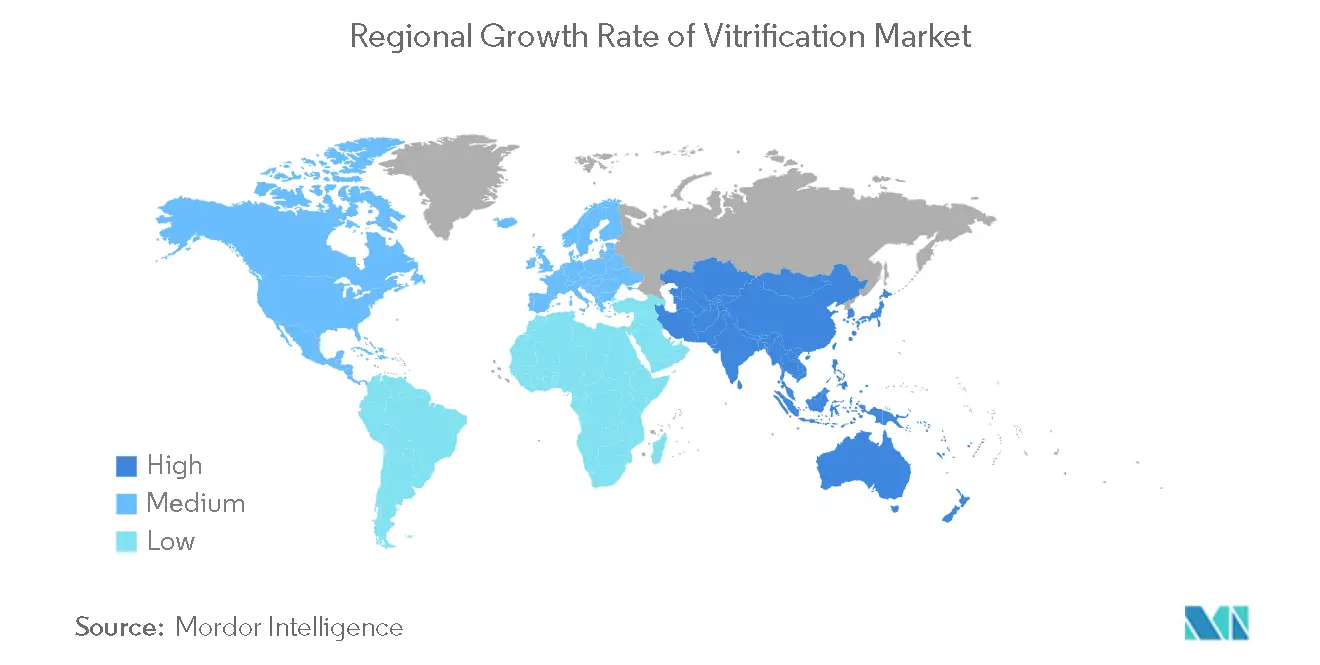
Vitrification Industry Overview
The vitrification market is moderately fragmented competitive and consists of several major players. In terms of market share, a few of the major players are currently dominating the market. Some of the companies which are currently dominating the market are Kitazato Corporation, IVF Store, Vitrolife, Cryotech, Cook medical, Minitube, IMV Technologies among others.
Vitrification Market Leaders
Kitazato Corporation
IVF Store
Vitrolife
Cryotech
COOK MEDICAL LLC
*Disclaimer: Major Players sorted in no particular order
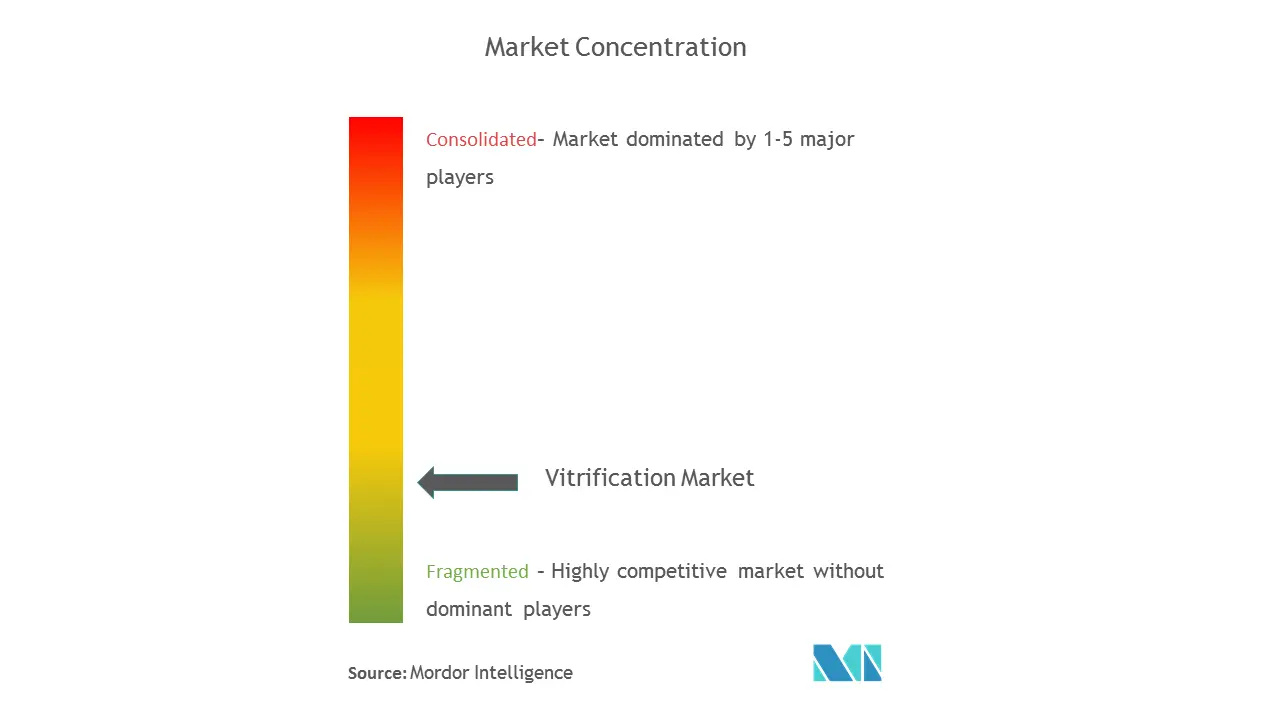
Vitrification Market News
In January 2021, CooperSurgical, one of the major providers of women's health care solutions, has purchased Embryo Options, a well-known provider of cryo-storage software for clinics and consumers. CooperSurgical's broad array of breakthrough fertility treatments will be enhanced by this acquisition. Clinics that work with Embryo Options benefit from automated billing and streamlined management of cryopreserved embryos, eggs, and sperm, which leads to higher collections, lower specimen abandonment, and lower cryo-inventory management costs.
In July 2021, Vitrolife AB has signed a binding agreement to purchase all of Igenomix's shares. By uniting the knowledge, product portfolios, and market presence of two top companies in IVF medical equipment and reproductive genetic testing services, the merger will establish one of the global leaders in reproductive health.
Vitrification Market Report - Table of Contents
1. INTRODUCTION
1.1 Study Assumptions and Market Definition
1.2 Scope of the Study
2. RESEARCH METHODOLOGY
3. EXECUTIVE SUMMARY
4. MARKET DYNAMICS
4.1 Market Overview
4.2 Market Drivers
4.2.1 Growth in Fertility Preservation Techniques
4.2.2 Delayed Childbearing due to Sociodemographic Factors
4.2.3 Increasing Rate of Infertilities
4.2.4 Increasing Awareness in Reproductive Health
4.3 Market Restraints
4.3.1 Ethical Concerns About The Preservation of Eggs and Sperms
4.4 Porter's Five Force Analysis
4.4.1 Threat of New Entrants
4.4.2 Bargaining Power of Buyers/Consumers
4.4.3 Bargaining Power of Suppliers
4.4.4 Threat of Substitute Products
4.4.5 Intensity of Competitive Rivalry
5. MARKET SEGMENTATION
5.1 By Specimen
5.1.1 Oocytes
5.1.1.1 Devices
5.1.1.2 Kits & Consumables
5.1.2 Embryo
5.1.2.1 Devices
5.1.2.2 Kits & Consumables
5.1.3 Sperm
5.2 By End User
5.2.1 Invitro Fertilization Clinics
5.2.2 Biobanks
5.3 Geography
5.3.1 North America
5.3.1.1 United States
5.3.1.2 Canada
5.3.1.3 Mexico
5.3.2 Europe
5.3.2.1 Germany
5.3.2.2 United Kingdom
5.3.2.3 France
5.3.2.4 Italy
5.3.2.5 Spain
5.3.2.6 Rest of Europe
5.3.3 Asia-Pacific
5.3.3.1 China
5.3.3.2 Japan
5.3.3.3 India
5.3.3.4 Australia
5.3.3.5 South Korea
5.3.3.6 Rest of Asia-Pacific
5.3.4 Middle-East and Africa
5.3.4.1 GCC
5.3.4.2 South Africa
5.3.4.3 Rest of Middle-East and Africa
5.3.5 South America
5.3.5.1 Brazil
5.3.5.2 Argentina
5.3.5.3 Rest of South America
6. COMPETITIVE LANDSCAPE
6.1 Company Profiles
6.1.1 COOK MEDICAL LLC
6.1.2 CooperSurgical, Inc.
6.1.3 Cryotech
6.1.4 FUJIFILM Irvine Scientific
6.1.5 IMV TECHNOLOGIES GROUP
6.1.6 IVF Store
6.1.7 Kitazato Corporation
6.1.8 MINITÜB GMBH
6.1.9 Shenzhen VitaVitro Biotech
6.1.10 Vitrolife
- *List Not Exhaustive
7. MARKET OPPORTUNITIES AND FUTURE TRENDS
Vitrification Industry Segmentation
As per the scope of this report, vitrification is a technique used in the freezing of embryos and eggs so that they can be kept for later use. Vitrification techniques are useful for preserving cells and tissues, and it has a wide range of uses in reproductive biology and regenerative medicine. It is used in human fertility preservation, cell storage for tissue regeneration, cell therapy, and gamete and embryo banking, among other things. The vitrification market is segmented By Specimen (Oocytes (Devices and Kits & Consumables), Embryo (Devices and Kits & Consumables), and Sperm)), By End User (IVF Clinics and Biobanks), and Geography (North America, Europe, Asia-Pacific, Middle East and Africa, and South America). The vitrification market is projected to register a CAGR of 15.9% during the forecast period. The market report also covers the estimated market sizes and trends for 17 different countries across major regions, globally. The report offers the value (in USD million) for the above segments.
| By Specimen | ||||
| ||||
| ||||
| Sperm |
| By End User | |
| Invitro Fertilization Clinics | |
| Biobanks |
| Geography | ||||||||
| ||||||||
| ||||||||
| ||||||||
| ||||||||
|
Vitrification Market Research FAQs
What is the current Global Vitrification Market size?
The Global Vitrification Market is projected to register a CAGR of 15.90% during the forecast period (2024-2029)
Who are the key players in Global Vitrification Market?
Kitazato Corporation, IVF Store, Vitrolife, Cryotech and COOK MEDICAL LLC are the major companies operating in the Global Vitrification Market.
Which is the fastest growing region in Global Vitrification Market?
Asia-Pacific is estimated to grow at the highest CAGR over the forecast period (2024-2029).
Which region has the biggest share in Global Vitrification Market?
In 2024, the Europe accounts for the largest market share in Global Vitrification Market.
What years does this Global Vitrification Market cover?
The report covers the Global Vitrification Market historical market size for years: 2019, 2020, 2021, 2022 and 2023. The report also forecasts the Global Vitrification Market size for years: 2024, 2025, 2026, 2027, 2028 and 2029.
Vitrification Industry Report
Statistics for the 2024 Vitrification market share, size and revenue growth rate, created by Mordor Intelligence™ Industry Reports. Vitrification analysis includes a market forecast outlook 2029 and historical overview. Get a sample of this industry analysis as a free report PDF download.
